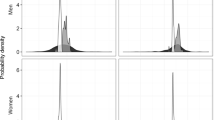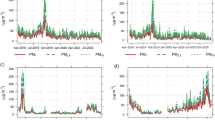Abstract
The Ma-tsu Goddess parade is a very special religious tradition in Taiwan attracting thousands of believers every year. This parade is an 8-day-and-7-night event and the entire walking distance is about 280 km. This study assesses participants' exposure to PM2.5, and gaseous and particulate PAHs. The contribution of various exposure factors was also evaluated. Sampling was conducted during the entire parade period in 2001. Exposures of participants who were riding motorcycles or driving cars were assessed. Personal environmental monitors mounted with Teflon filters and polyurethane foams were used for particulate and gaseous sampling. PAHs were analyzed with GC-FID. Stepwise regression analysis was used to evaluate the contribution of various factors, including the number of temples visited each day, the duration of temple visits, the number of temple co-visitors, visitors riding motorcycles or driving cars, etc. During the Ma-tsu Goddess parade, the mean PM2.5, particulate and gaseous PAH exposures were around 119±60.8, 0.36±0.23 and 0.86±0.48 μg/m3, respectively. Participants' PM2.5 and particulate PAH exposures were about two to three times the exposure during daily routines. The profiles of 16 PAH species in the particulate and gaseous phases for participants' and normal daily exposures were also different. Incense smoke and vehicle exhaust were two important sources. Worshippers would be exposed to 0.096 μg/m3 more PM2.5 for every incremental minute in temples. In addition, motorcyclists were exposed to 0.21 μg/m3 higher particulate PAHs than the car drivers.
This is a preview of subscription content, access via your institution
Access options
Subscribe to this journal
Receive 6 print issues and online access
$259.00 per year
only $43.17 per issue
Buy this article
- Purchase on Springer Link
- Instant access to full article PDF
Prices may be subject to local taxes which are calculated during checkout






Similar content being viewed by others
References
Chang H. The stratification of Sacred Space: example of the Ta-Chia pilgrimage. In: Huang Y . K . (Ed.). Space, Power and Society. Institute of Ethnology, Academia Sinica, Taipei, Taiwan, 1995: pp. 351–390 (in Chinese).
Chang H. Anthropolygy II: Popolar Religions. Rite and society: The Expansion and Change of the Ta-Chia Ma-tsu Worship Groups. Third International Conference on Senology, Academia Sinica, Taipei, Taiwan, June 29 – July 1, 2000: (in Chinese).
Chen I.S. Polycyclic Aromatic Hydrocarbons in Motorcycle Exhaust. Master thesis, Institute of Atomic Science, National Tsing Hua University, Hsinchu, Taiwan, June, 1996: (in Chinese).
Hsu Y.W. Characterization of Polycyclic Aromatic Hydrocarbons and Exposure Assessment from Multiple Pollution Source. Master thesis, Institute of Toxicology, Chung Shan Medical Dental College, Taichung, Taiwan, June, 1999: (in Chinese).
Lung S.-C.C., and Hu S.C. Generation rates and emission factors of particulate matter and particle-bound polycyclic aromatic hydrocarbons of incense sticks. Chemosphere 2003: 50: 673–679.
Lung S.-C.C., and Kao M.C. Worshippers' exposure to particulate matter in two temples in Taiwan. J Air Waste Manage Assoc 2003: 53: 130–135.
Lung S.-C.C., Kao M.C., and Hu S.C. Contribution of incense burning to indoor PM10 and particle-bound polycyclic aromatic hydrocarbons under two ventilation conditions. Indoor Air 2003: 13: 194–199.
Marr L.C., Kirchstetter T.W., Harley R.A., Miguel A.H., Hering S.V., and Hammond S.K. Characterization of polycyclic aromatic hydrocarbons in motor vehicle fuels and exhaust emissions. Environ Sci Technol 1999: 33: 3091–3099.
Mi H.H. Emission Characteristics of Polycyclic Aromatic Hydrocarbons from Mobile Sources. PhD dissertation, Institute of Environmental Engineering, National Chung Kung University, Tainan, Taiwan, June, 1998: (in Chinese).
Sung L.F. Two examples of the pilgrimage activities in Taiwan. Bull. Inst. Ethnol, Acad Sini Spring 1971: 31: 65–134.
Tseng K.C. Polycyclic Aromatic Hydrocarbons from Burning Raw Materials for a Chinese Incense. MS thesis, National Taiwan University, Taipei, Taiwan, June, 1996: (in Chinese).
United States Environmental Protection Agency. Method 610 Methods for Organic Chemical Analysis of Municipal and Industrial Wastewater, EPA-600/4-82-057 Environmental Monitoring and Support Laboratory, Cincinnati, OH, July, 1982.
United States Environmental Protection Agency. Integrated Risk Information System. United States Environmental Protection Agency, Washington DC, last revised March 3 1, 1987.
Wilson R., and Spengler J. Particles in our Air: Concentrations and Health Effects. Harvard University Press, Cambridge, MA, 1996.
Acknowledgements
We thank all subjects who participated for their help with our sampling.
Author information
Authors and Affiliations
Corresponding author
Rights and permissions
About this article
Cite this article
Lung, SC., Guo, KJ., Chen, PY. et al. Participants' exposure to PM2.5 and gaseous/particulate polycyclic aromatic hydrocarbons during the Ma-tsu Goddess parade. J Expo Sci Environ Epidemiol 14, 536–543 (2004). https://doi.org/10.1038/sj.jea.7500372
Received:
Accepted:
Published:
Issue Date:
DOI: https://doi.org/10.1038/sj.jea.7500372
Keywords
This article is cited by
-
Incense smoke: clinical, structural and molecular effects on airway disease
Clinical and Molecular Allergy (2008)
-
Exposure to carcinogenic PAHs for the vendors of broiled food
Journal of Exposure Science and Environmental Epidemiology (2006)
-
Exposure to carcinogenic PAHs for the vendors of broiled food
Journal of Exposure Science & Environmental Epidemiology (2006)



